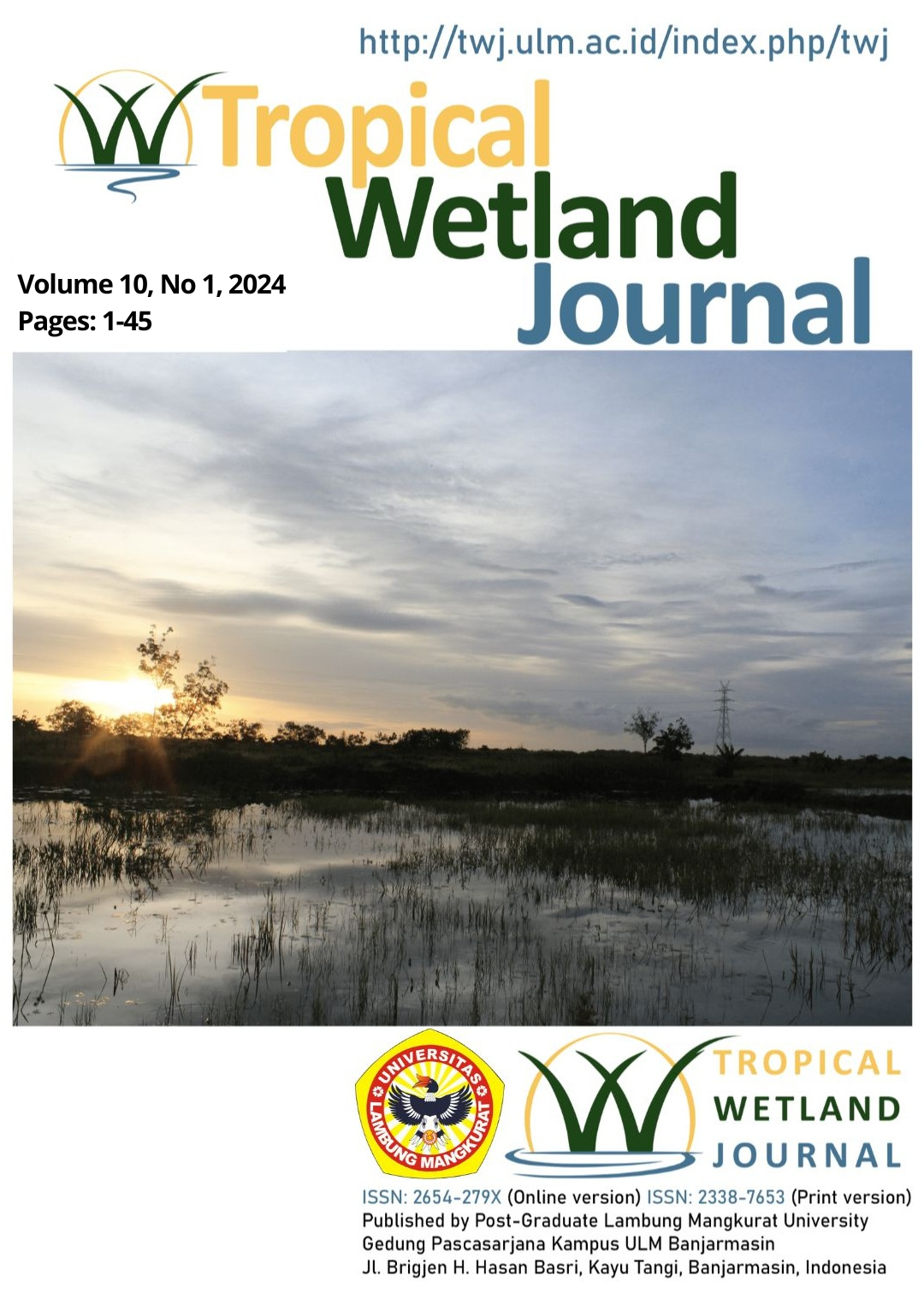Isolation of Bacillus thuringiensis from Type B Tidal Lands
Main Article Content
Abstract
Bacillus thuringiensis is a disease-causing bacterium in insects that is used to control insect pests that attack crops, both crops and horticultural crops. This bacterium can be isolated from plant residues that have become compost, infected insects, and soil. Isolation was carried out to take bacteria from their natural environment and grow them in artificial media. In swamps, there are important microorganisms involved in the decomposition of organic matter. The microbes that play a role consist of fungi and bacteria, for instance, those are found in rice plantations in Barito Kuala swamps, which include the Actinomycetes, Bacillus, Cromobacterium, and Pseudomonas bacteria groups. B. thuringiensis is widely distributed in nature but is rare due to the many different Bacillus isolates. Therefore, it was necessary to conducted research to determine the presence of B. thuringiensis in plant root areas in more specific soils to increase the possibility of finding B. thuringiensis. This study aims to determine the number of B. thuringiensis isolates obtained in type B tidal land ecosystems. This research was conduct from December 2021 to June 2022 at the Integrated Laboratory and Production Laboratory, Department of Agroecotechnology, Faculty of Agriculture, University of Lambung Mangkurat. This research used a descriptive method. Soil collection was carried out by purposive sampling (sampling technique with certain considerations) in the planting area in tidal land type B. Soil samples were taken from 3 places as a comparison, namely in the rice planting area, orange planting area, and banana planting area B. The parameters observed in this study were the number of colonies, the macroscopic and microscopic shape characteristics of the bacteria, the gram of bacteria, and the test of the killing power of bacteria against P. xylostella insects. Based on the parameters that have been observed, the highest number of colonies was found in citrus plantation samples, with 98 colonies.
Article Details
Section

TROPICAL WETLAND JOURNAL is licensed under a Creative Commons Attribution-ShareAlike 4.0 International License.
How to Cite
References
Apsal, Perdinand, H., Napoleon, Adipati, Sulistyani, Probowati, D. (2018). Exploration of microorganisms in tidal swamp lands in four types of land floods. Thesis, Sriwijaya University, Palembang.
Bahagiawati. (2002). Uses of bacillus thuringiensis as a bioinsecticide. AgroBio Bulletin, 5(1): 21-28.
Gazali, A., Jaelani, A., & Ilhamiyah. (2015). Patogenicity of Bacillus thuringiensis which Isolated from tidal ecosystem against diamond backmoth larvae, Plutella xylostella Linn. Asian Journal of Applied Sciences, 3(3): 513-518.
Hajoeningtijas, O. D. (2012). Agricultural microbiology. Yogyakarta: Graha Ilmu.
Hatmoko, D., Aries, M., & Anwar, K. (2006). Potential distribution of swamp land based on typological area and overflow type in South Kalimantan (Map Sheets 1712,1713,1812,1813). Banjarbaru: Swampland Agricultural Research Institute (BALITTRA).
Irfanti, D. Y. (2020). Bacillus sp. and Pseudomonas fluorescents antagonist test from bamboo rhizosphere, elephant grass and putri malu in suppressing Ralstonia Solanacearum Bacteria. Thesis, Lambung Mangkurat University, Banjarbaru.
Irianto, H. E. (2012). Fish fermentation products. Jakarta: Penebar Swadaya.
Khetan, S. K. (2006). Microbial pest control. Boca Raton: CRC Press. DOI: https://doi.org/10.1201/9781482270631.
Maftu’ah, E., Mukhlis & Susanti, M. A., (2007). Potential soil fauna in swamp land. Final Report of Research Results. Banjarbaru: Swampland Agricultural Research Institute (BALITTRA).
Poinar, G. O., & Thomas, G. M. (1984). Identification of the categories of insect pathogens and parasites. In: Laboratory Guide to Insect Pathogens and Parasites. Springer, Boston, MA. DOI: https://doi.org/10.1007/978-1-4684-8544-8_1.
Rizali, A. (1992). Isolation of Bacillus Thuringiensis from South Kalimantan Soil and Screening of Isolates Against Cabbage Worm, Cricodolomia Binotalis Zeller. Thesis, University of the Phillipines Los Banos, Philippines.
Sabbathini, G. C., Pujiyanto, S., Wijanarka & Lisdiyanti, P. (2017). Isolation and identification of bacteria of the genus Sphingomonas from rice leaves (Oryza sativa) in the Cibinong rice fields area. Jurnal Biologi, 6(1): 59-64.
Saputra, R. A., & Sari, N. N. (2021). Ameliorant engineering to elevate soil pH, growth, and productivity of paddy on peat and tidal land. IOP Conf. Series: Earth and Environmental Science, 648: 012183. DOI: https://doi.org/10.1088/1755-1315/648/1/012183.
Seniati, Marbiah & Nurhayati. (2017). Study of confrontation tests against pathogenic bacteria using the spread method, pour method and scratch method. Galung Tropika Journal, 6(1): 42-48.
Singleton, P., & Sainsbury, D. (2006). Dictionary of Microbiology and Molecular Biology. 3rd Edition, Jhon Wiley and Sons, Sussex. DOI: https://doi.org/10.1002/9780470056981.
Trizelia. (2001). Utilization of Bacillus thuringiensis to control the pest Crocidolomia binotalis. Dissertation, Postgraduate Program, Bogor Agricultural Institute, Bogor.

